Iprepping
survival is key. Be ready be prepared
Monday, August 31, 2015
MY NEW HOME!
After a long absence, I have finally been able to come back and run a true prepping and survival blog. I now have a new and better website! It is called http://prepandsurvial.com/ come check it out, and join me in growing a prepping and survival community!
Tuesday, May 20, 2014
How To Purify Water
How To Purify Water
“Water, water everywhere and not a drop to drink,” as the old saying goes. A more apt statement for these times might be, “water, water everywhere, but is it safe to drink?” And if it’s not, what is a reliable water purification process?Sadly, in this day and age there are few, if any, places where the water is safe to drink without treating, no matter how pristine and inviting it may look.
Water in the wild often contains harmful microorganisms, bacteria and parasites that can cause a variety of ailments, such as giardia, dysentery, hepatitis, and hookworms.
I. How to Purify Water — Water Purification Process: boiling
The simplest method to purify water is probably boiling.You need to bring the water to a full, rolling boil for at least five minutes to be safe, with some experts recommending an even longer time. The down side to boiling your drinking water is that it removes the oxygen and the water ends up tasting flat. You can improve its quality by pouring it back and forth between two containers to put oxygen back in, or simply shake it up.
II. Water Purification Process: purifiers
There are also several chemical purifiers on the market. Iodine comes in either liquid form, (which can be messy), or tablet form.One to two tablets or drops will clear up a quart of water. Shake your water bottle or container and wait twenty minutes before drinking. Water treated with iodine will have a darker color and a bit of an unpleasant flavor.
It is possible to mask this flavor by adding a powdered drink mix, but be sure to wait the twenty minutes before adding it, as it will interfere with the iodine’s effectiveness.
Other chemical treatments to purify water that work similarly to iodine are chlorine tablets, potassium permanganate, or halazone tablets. You should be able to pick these up fairly cheaply at most outdoor stores.
You can even add a few drops of bleach in a pinch, though I wouldn’t recommend overusing this one. It is important when using chemical purification to make sure all surfaces have been decontaminated.
After waiting the twenty minutes, slightly unscrew the lid of your water bottle or container and rinse around the threads and lid. The nice thing about using tablets is the container is very small and portable and can be slipped into a pocket, a plus if you do not want to carry a stove or pot, or take the time to boil water. Chemical treatment can be done on the hoof with minimal stopping time.
III. Water Purification Process: filters
A third method of treatment is commercial filters. These come in all shapes, sizes and price ranges. Most work by pushing the water through a charcoal or ceramic filter and then chemically treating it. Normally, they have one hose with a float that goes from the water source to the filter and a second hose, for clean water, that goes from filter to water bottle. When using this type of filter it is important to not cross contaminate the hoses. Keep the clean hose in a separate plastic bag so it never touches the contaminated hose. The plus side to this method of how to purify water is that there is no flat or funky flavor. Commercial filters are also good for when the water is on the murky or dirty side, as they will remove this also. The drawback is that the sediment or tannins that you are filtering out will quickly clog up the filter. Some can be cleaned, with others you need to buy a replacement filter. Like all technical equipment, cost and breakage are things to be considered.IV. Water Purification Process: primitive methods
Beyond these common methods, there are more primitive techniques for the serious survivalists (or the unlucky person who was caught unprepared).One is filtering through soil or, preferably, sand. Keep rinsing the water repeatedly through the sand until it is looking clear. A variation of this is to dig a hole near where the source is and use the water that filters through into the hole. Be aware, that although soil is a good filter for sediment and other particles, it is not a guarantee for things like bacteria. This is even true for spring water, which many people assume is safe to drink without treatment.
Distilling is a method that can be used for either collecting water or gathering fresh water out of salt water.
To collect water from the ground, dig a deep hole and place a collecting container or water bottle in the center.
Cover the hole with a clear sheet of plastic. The plastic needs to be weighted in the center with a rock or heavy object so that it points down into the container.
Then, secure the sides of the plastic tightly around the hole, such as by covering with dirt. The clear plastic acts like a greenhouse. The water in the soil evaporates as it heats up. When it hits the plastic it runs down to the point and drips off into the container. If all you have is salt water, you can distill it by placing a small pot inside a larger pot. The salty water goes in the larger pot but not the smaller one.
Invert a lid over the pots that will point down into the smaller pot, then bring the water to a boil. As the water boils, fresh water will evaporate, hit the lid and drip down into the smaller pot, leaving the salt, or other minerals behind.
An alternative if you don’t have a smaller pot is to put a cloth over the pot the will absorb the steam. Use caution when removing it to wring it out so you don’t get burned.
For another primitive method of how to purify water, see our article on Boiling Water with Stones.
Above all, be cautious and use common sense when choosing where to gather your water.
Do the plants surrounding it look healthy?Are there dead animals near by that might have contaminated it?
Don’t collect any water that looks stagnant. Generally, water that is further upstream will be cleaner than that downstream, but there are no guarantees.
Don’t automatically go for the fasting rushing water, as fast water carries more sediment. You can avoid picking up a lot of sediment by making sure you dunk your water bottle completely under the water. This will avoid all the dirt and debris that floats on the surface.
With so many ways to purify water, there should be something for everyone and no reason to ever take chances drinking untreated water.
Sunday, April 13, 2014
Determining Directions Without a Compass
DETERMINING DIRECTIONS WITHOUT A COMPASS
There are two types of compasses, (a) liquid filled and (b) non-liquid filled. Liquid filled means the compass is filled with some special liquid so the magnetic needle floats freely inside of it. Non-liquid filled means there's no liquid inside of it (duh?) but instead the magnetic needle is able to rotate freely while being balanced on one or two pins inside the compass. So which is better? They both have their pros and cons, the only difference is that the North seeking magnetic needles inside liquid filled compasses rotate & move slower than non-liquid filled compasses. But regardless of which type of generl direction compass you have or get with your survival kit, they're a lot more easier to use in determining directions than these techniques below "without a compass."
|
SUN & STICK METHOD(Sunlight required)
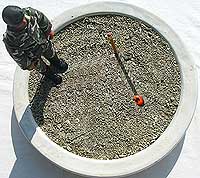 | 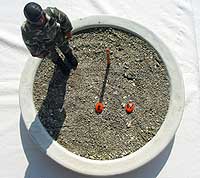 | 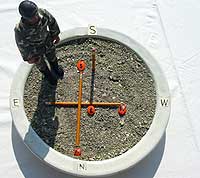 |
Steps 1, 2, & 3
|
Steps 4 & 5
|
Steps 6 & 7
|
Step 1: Try to find some flat level area with very little or no vegetation at all.
Step 2: Place a straight stick upright into the ground and find the stick's shadow.
Step 3: Now place your 1st rock at the tip of the stick's shadow, this is your "West"mark.
Step 4: Wait approximately 15, 20 or 30 minutes for the stick's shadow to move a few inches.
Step 5: Now place another rock at the tip of this other stick's shadow, this is your "East" mark.
Step 6: Now draw a straight line or place a straight stick from your "East" rock to your "West" rock.
Step 7: And now draw another straight line or place another straight stick across your "East-to-West" line/stick and this is now your "North-South" line/stick.Note: The instructions listed above is for the Northern hemisphere, for the Southern hemisphere the only difference is that North and South are reversed, East and West remain the same.
CLOCK METHOD(Sunlight required)
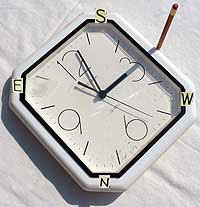 | 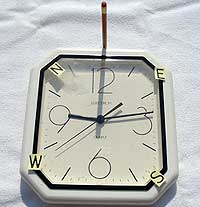 |
Northern Hemisphere
|
Southern Hemisphere
|
Step 1: Point the hour hand at the sun
|
Step 1: Point 12 O'clock at the sun
|
Step 2: South is located halfway between the hour hand and 12 O'clock. North is in the opposite directions
|
Step 2: North is located halfway between 12 O'clock and the "hour hand." South is in the opposite direction.
|
CLOUDY DAY METHOD(When there's no sunlight.)
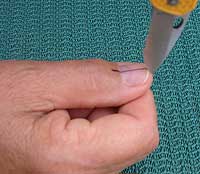
Step 1: Place a sharp pointed knife vertically on your thumb nail.
Step 2: Look closely at your thumb nail and find the lightly cast knife shadow.
Step 3: Now rotate your entire body until the lightly cast knife shadow is at it's thinnest.
Step 4: If it's morning (0700-1100) you will be facing an Easterly direction, mid day (1100-1300)
you will be facing a Southernly direction, and in the afternoon you will be facing a Westernly direction.Note: Though this method is less accurate than the other two methods. But if you don't have a compass or any sunlight it's hellova lot better than flipping a coin in determing a direction, don't ya think? Remember if you're located in the Southern hemisphere "South" and "North" are reversed.
MOON & STAR METHOD(Stars & moon required)
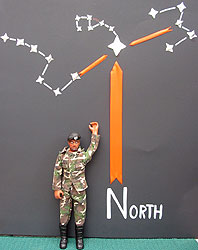 | 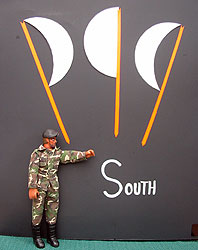 |
Finding North by using the stars
|
Finding South by using the moon
|
The North star can be found between the big dipper's last two "pot" stars that's in line with the last star of the little dipper's handle and the Cassiopeia
|
Draw an imaginary line or hold up a straight stick from one moon crescent point to the other and directly below it on the horizon you will find South
|
TREE METHOD(No sunlight required)
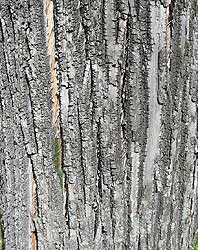 |  |
Wider grain on South side
|
Moss grows on the North side
|
In the Northern hemisphere trees with thick, rough, linear bark, the up & down grain lines are usually wider on the South side and tighter on North side.
|
In the Northen hemisphere moss found near the base of trees usually grows on the Northern side where the sun's rays don't reach.
|
Sunday, July 7, 2013
The 100 most important items you will need when the shit hits the fan
The 100 most important things you’ll need to survive after the grid collapses!! These items (Not in order, just randomly listed) are things you will need if you made it through bugging out and now you’re at your check point.All items on this list are important; the first 51 are the most important. Items 52 – 87 will make living much easier!! Items 88 – 100 are equally important to acquire; they serve a very important purpose as well!! Rev. 12/26/10.1. Generators/Solar panels (Good ones cost dearly. Gas storage can be risky. Generators are noisy, draws attention to your location, target of thieves; maintenance)2. Water Filters/Purifiers (.1 or .2 micron to prevent diarrhea/illness) purification tablets3. Bleach and Lye!! (plain bleach, NOT scented: 4 to 6% sodium hypochlorite)4. Seasoned Firewood. Wood takes about 6 - 12 months to become dried.5. Lamp Oil, kerosene, Wicks, Lamps (Buy CLEAR unscented oil.)6. Coleman Fuel. Impossible to stockpile too much.7. Guns, Ammo, Pepper Spray, Knives, Clubs, Bats, slingshots, gun power, pellets, BB’s, wick, bombs. You can never have too many weapons or ammo!! Stock up!! Hide them!!8. Hand-can openers, & hand egg beaters, whisks.9. Honey/Syrups/white, brown sugar, iodized salt10. Rice - Beans - Wheat11. Vegetable Oil A MUST!!(For cooking) Without it food burns or must be boiled)12. Charcoal, Lighter Fluid (Will become scarce suddenly)13. Water Containers (Urgent Item to obtain.) Any size. Small: HARD CLEAR PLASTIC ONLY - note - food grade if for drinking.14. Mini Heater head (Propane) (Without this item, propane won't heat a room.)15. Socks, Underwear, long & short sleeve shirts/ winter clothes and gear, camo!!16. Propane Cylinders (Urgent: Definite shortages will occur.)17. Canned Fruits, Veggies, Soups, stews, chicken, tuna, beef, pork, rice, beans, pasta, sauces, you can never have too much food!!18. Lanterns, mantles, glass globes, Coleman, Aladdin, etc. (For long-term lighting)19. Baby Supplies: Diapers/formula, ointments/aspirin etc.20. Paraffin wax, baby oil, cocoa butter, canola oil, bee’s wax21. Popcorn, Peanut Butter, Nuts22. Graham crackers, saltines, pretzels, Trail mix/Jerky23. Boy Scout Handbook, survival guide, also Leaders Catalog24. Feminine Hygiene/Hair care/Skin products/ sun screen.25. Thermal underwear wool and cotton mix, polypropylene (Tops & Bottoms)26. Bow saws, axes, hatchets, Wedges, honing oil, shovel, rake, hoe,27. "Survival-in-a-Can"28. Reading glasses29. Hand pumps & siphons (for water and for fuels)30. Toilet Paper, Kleenex, alcohol, peroxide, eye drops, Paper Towels, hand soap, dish soap31. Shaving supplies (razors & creams, talc, after shave)32. Garden Seeds (Non-Hybrid A MUST)33. Rain gear, rubberized boots, etc.34. Baby wipes, baby oil, cocoa butter, bees wax, hand creams and lotions, waterless & Antibacterial gel soap (saves a lot of water)35. Tuna Fish (in oil)36. Fire Extinguishers (or..large box of Baking Soda in every room)37. First aid kits, lots of different bandages, spray on, arm slings, knee and arm supports, crutches,38. Batteries (all sizes...buy furthest-out for Expiration Dates)39. Sleeping Bags & blankets/pillows/mats40. Knives, Sharpening tools, files, stones, steel, machete, filet, survival, multi tool41. Survival Guide Book.42. "Strike Anywhere" matches Boxed, wooden, lighters, magnesium fire striker, Vaseline cotton balls, trioxine.43. Garden tools & supplies44. Backpacks, Duffel Bags45. Work boots, hiking insulated boots, Levis, durable shirts, hunting & military camo46. Flashlights/LIGHTSTICKS & torches, "No. 76 Dietz" Lanterns47. Candles and a Bible48. Tarps / stakes / twine / nails / rope / spikes / duck tape49. Men's Hygiene: Shampoo, Toothbrush/paste, Mouthwash/floss, nail clippers50. Vitamins, cold, flu, and diarrhea medicine, cough tablets & syrup, Vicks vapor rub!!51. Fishing supplies/tackle box/poles/tools52. Garlic, spices & vinegar, baking supplies53. Coleman's Pump Repair Kit54. Hats & cotton neckerchiefs, gloves, mittens, scarves55. Atomizers (for cooling/bathing)56. Wine/Liquors (for bribes, medicinal, etc,)57. Cigarettes, tobacco for smoking, chewing or trading.58. Coffee / powered creamer/ sugar / artificial sweetener59. Teas60. Glue, nails, nuts, bolts, screws, zip ties - all sizes, rope61. Lantern Hangers62. Gloves: Work/warming/gardening, etc.63. Cots & Inflatable mattress's64. Wagons & carts (for transport to and from)65. Tool box, hammer, wrenches all types, screw drivers, pliers, hacksaw, black & duct tape, extension cords, bungee cords, hose & "C" clamps, screen patches,66. Woolen clothing, scarves/ear-muffs/mittens 67. /Chocolate/Cocoa/Tang/Punch (water enhancers)68. Soy sauce, vinegar, bullions/gravy/soup base69. Paper plates/cups/utensils (stock up, folks)70. Critter snap traps to catch rabbits, coons and the like to eat!!71. Board Games, Cards, Dice72. Bicycles...Tires/tubes/pumps/chains, etc73. Canning supplies, (Jars/lids/wax)74. Scissors, fabrics & sewing supplies75. Laundry Detergent (liquid)76. Mosquito coils/repellent, sprays/creams77. Cast iron cookware (sturdy, efficient)78. Garbage cans Plastic (great for storage, water, transporting - if with wheels79. Insulated ice chests are good for keeping items from freezing in winter time.80. Writing paper/pads/pencils, solar calculators81. Flour, yeast & iodized salt82. Milk - Powdered & Condensed (Shake Liquid every 3 to 4 months)83. Garbage Bags (Impossible To Have Too Many).84. Gasoline Containers (Plastic & Metal)85. Propane Cylinders and base Holders (The small canisters are dangerous without the base holder; they tip over and catch fire!!)86. Duct Tape87. Cook stoves (Propane, Coleman & Kerosene)88. Chewing gum/candies89. Roll-on Window Insulation Kit (MANCO)90. Carbon Monoxide Alarm (battery powered)91. Journals, Diaries & Scrapbooks (jot down ideas, feelings, experiences)92. Grain Grinder (Non-electric)93. Clothes pins/line/hangers (A MUST)94. Aluminum Foil Reg. & Heavy Duty (Great Cooking and Barter Item)95. Washboards, Mop Bucket w/wringer (for Laundry)96. Big Dogs (and plenty of dog food)97. Portable Toilets98. Mousetraps, Ant & cockroach traps, d-con Rat poison, MOUSE PRUFE II, Roach Killer99. Lumber (all types)100. Goats/chickens/cowsFrom a Sarajevo War Survivor: Experiencing horrible things that can happen in a war - death of parents and friends, hunger and malnutrition, endless freezing cold, fear, sniper attacks.1. Stockpiling helps, but you never know how long trouble will last, so locate near renewable water and food sources.2. Living near a well with a manual pump is like being in Eden.3. After awhile, even gold can lose its luster. But there is no luxury in war quite like toilet paper. Its surplus value is greater than gold's.4. If you had to go without one utility, lose electricity - it's the easiest to do without (unless you're in a very nice climate with no need for heat.)5. Canned foods are awesome, especially if their contents are tasty without heating. One of the best things to stockpile is canned gravy - it makes a lot of the dry unappetizing things you find to eat in war somewhat edible. Only needs enough heat to "warm", not to cook. It's cheap too, especially if you buy it in bulk.6. Bring some books - escapist ones like romance or mysteries become more valuable as the war continues. Sure, it's great to have a lot of survival guides, but you'll figure most of that out on your own anyway - trust me, you'll have a lot of time on your hands.7. The feeling that you're human can fade pretty fast. I can't tell you how many people I knew who would have traded a much needed meal for just a little bit of toothpaste, rouge, soap or cologne. Not much point in fighting if you have to lose your humanity. These things are morale-builders like nothing else.8. Slow burning candles and matches, lighters and magnesium fire strikers
Wednesday, September 19, 2012
The Government is watching you
Every Breath You Take, Every Move You Make – 14 New Ways That The Government Is Watching You
The American Dream
November 3, 2011
November 3, 2011
If you live in the United States today, you need to understand that your privacy is being constantly eroded. Our world is going crazy, government paranoia is off the charts and law enforcement authorities have become absolutely obsessed with watching us, listening to us, tracking us, recording us, compiling information on all of us and getting us all to spy on one another. If you doubt that we are rapidly getting to the point where the government will monitor every breath you take and every move you make, just read the rest of this article. The truth is that the government is watching you more closely than ever, and they are spending billions upon billions of dollars to enhance their surveillance capabilities even further. If our society stays on this current path, we will eventually have zero privacy left. At this point, it is not too hard to imagine a society where we will not be able to say anything, buy anything, sell anything, assemble with others or even leave our homes without government permission. We truly are descending into a dystopian nightmare and the American people had better wake up.
Sadly, most people living in the United States and in Europe do not realize what is happening. Most of them think that everything is just fine. The “Big Brother control grid” that is being constructed all over the western world squeezes all of us just a little bit tighter every single day, and most people don’t even feel it.
But when you step back and take a look at the big picture, it truly is horrifying.
The following are 14 new ways that the government is watching you….
#1 In many areas of the United States today, you will be arrested if you do not produce proper identification for the police. In the old days, “your papers please” was a phrase that we used to use to mock the tyranny of Nazi Germany. But now all of us are being required to be able to produce “our papers” for law enforcement authorities at any time. For example, a 21-year-old college student named Samantha Zucker was recently arrested and put in a New York City jail for 36 hours just because she could not produce any identification for police.
#2 The federal government has decided that what you and I share with one another on Facebook and on Twitter could be a threat to national security. According to a recent Associated Press article, the Department of Homeland Security will soon be “gleaning information from sites such as Twitter and Facebook for law enforcement purposes”.
Other law enforcement agencies are getting into the act as well. For example, the NYPD recently created a special “social media” unit dedicated to looking for criminals on social media networks such as Facebook and Twitter.
#3 New high-tech street lights that are being funded by the federal government and that are being installed all over the nation can also be used as surveillance cameras, can be used by the DHS to make “security announcements” and can even be used to record personal conversations. The following is from a recent article by Paul Joseph Watson for Infowars.com….
Federally-funded high-tech street lights now being installed in American cities are not only set to aid the DHS in making “security announcements” and acting as talking surveillance cameras, they are also capable of “recording conversations,” bringing the potential privacy threat posed by ‘Intellistreets’ to a whole new level.
#4 More than a million hotel television sets all over America are now broadcasting propaganda messages from the Department of Homeland Security promoting the “See Something, Say Something” campaign. In essence, the federal government wants all of us to become “informants” and to start spying on one another constantly. The following comes from an article posted by USA Today….
Starting today, the welcome screens on 1.2 million hotel television sets in Marriott, Hilton, Sheraton, Holiday Inn and other hotels in the USA will show a short public service announcement from DHS. The 15-second spot encourages viewers to be vigilant and call law enforcement if they witness something suspicious during their travels.
#5 The FBI is now admittedly recording Internet talk radio programs all over the United States. The following comes from a recent article by Mark Weaver of WMAL.com….
If you call a radio talk show and get on the air, you might be recorded by the FBI.The FBI has awarded a $524,927 contract to a Virginia company to record as much radio news and talk programming as it can find on the Internet.The FBI says it is not playing big brother by policing the airwaves, but rather seeking access to what airs as potential evidence.
Potential evidence of what?
This is very creepy. Why is the FBI so interested in what is being said during Internet talk radio programs?
#6 TSA VIPR teams are now conducting random inspections at bus stations and on interstate highways all over the United States. For example, the following comes from a local news report down in Tennessee….
You’re probably used to seeing TSA’s signature blue uniforms at the airport, but now agents are hitting the interstates to fight terrorism with Visible Intermodal Prevention and Response (VIPR).“Where is a terrorist more apt to be found? Not these days on an airplane more likely on the interstate,” said Tennessee Department of Safety & Homeland Security Commissioner Bill Gibbons.Tuesday Tennessee was first to deploy VIPR simultaneously at five weigh stations and two bus stations across the state.
#7 Thermal imaging face scanners are becoming much more sophisticated. Law enforcement authorities in the western world are getting very excited about “pre-crime” tools such as this that will enable them to “prevent crimes” before they happen. The following is from a recent BBC News article….
A sophisticated new camera system can detect lies just by watching our faces as we talk, experts say.The computerised system uses a simple video camera, a high-resolution thermal imaging sensor and a suite of algorithms.Researchers say the system could be a powerful aid to security services.
But face scanners are not just a tool that will be used in the future. The truth is that face scanners are being used all over the United States right now. The following comes from an article posted on Singularity Hub….
Law enforcement continues to adopt new technologies in an effort to make their jobs easier and keep us safer. The latest gizmo attaches to officers’ iPhones and turns them into biometric face scanners. The scanners have already been street tested in Massachusetts. Pretty soon cops all across the US will be using them to ID suspects.
Before long, technology like this will be all over America. In fact, the FBI has announced that it will be activating a “nationwide facial recognition service” in January.
#8 Another “pre-crime” technology currently being tested by the U.S. Department of Homeland Security is The Future Attribute Screening Technology (FAST) program. The following description of this new program comes from an article in the London Telegraph….
Using cameras and sensors the “pre-crime” system measures and tracks changes in a person’s body movements, the pitch of their voice and the rhythm of their speech.
It also monitors breathing patterns, eye movements, blink rate and alterations in body heat, which are used to assess an individual’s likelihood to commit a crime.
The Future Attribute Screening Technology (FAST) programme is already being tested on a group of government employees who volunteered to act as guinea pigs.
Do you want government officials to pull you aside and interrogate you just because you are feeling a little bit nervous one particular day?
#9 Sadly, “pre-crime” technology is even being used on our children. The Florida State Department of Juvenile Justice has announced that it will begin using analysis software to predict crime by young delinquents and will place “potential offenders” in specific prevention and education programs.
How soon will it be before this type of things is applied to adults?
#10 Our children are being programmed to accept the fact that they will be watched and monitored constantly. For example, the U.S. Department of Agriculture is spending large amounts of money to install surveillance camerasin the cafeterias of public schools all across the nation so that government control freaks can closely monitor what our children are eating.
#11 The U.S. government is also increasingly using “polls” and “surveys” as tools to gather information about all of us. In previous articles, I have noted how government authorities seems particularly interested in our children. According toMike Adams of Natural News, the CDC is starting to call parents all over the U.S. to question them about the vaccination status of their children….
The U.S. Centers for Disease Control, which has been comprehensively exposed as a vaccine propaganda organization promoting the interests of drug companies, is now engaged in a household surveillance program that involves calling U.S. households and intimidating parents into producing child immunization records. As part of what it deems a National Immunization Survey(NIS), the CDC is sending letters to U.S. households, alerting them that they will be called by “NORC at the University of Chicago” and that households should “have your child’s immunization records handy when answering our questions.”
You can see a copy of the letter that the CDC has been sending out to selected parents right here.
#12 As I have written about previously, a very disturbing document that Oath Keepers has obtained shows that the FBI is now instructing store owners to report many new forms of “suspicious activity” to them. According to the document, “suspicious activity” now includes the following….
*paying with cash
*missing a hand or fingers
*”strange odors”
*making “extreme religious statements”
*”radical theology”
*purchasing weatherproofed ammunition or match containers
*purchasing meals ready to eat
*purchasing night vision devices, night flashlights or gas masks
Do any of those “signs of suspicious activity” apply to you?
According to a report on WorldNetDaily, this document is part of a “series of brochures” that will be distributed “to farm supply stores, gun shops, military surplus stores and even hotels and motels.”
#13 In some areas of the country, law enforcement authorities are pulling data out of cell phones for no reason whatsoever. According to the ACLU, state police in Michigan are now using “extraction devices” to download data from the cell phones of motorists that they pull over. This is taking happening even if the motorists that are pulled over are not accused of doing anything wrong.
The following is how a recent article on CNET News described the capabilities of these “extraction devices”….
The devices, sold by a company called Cellebrite, can download text messages, photos, video, and even GPS data from most brands of cell phones. The handheld machines have various interfaces to work with different models and can even bypass security passwords and access some information.
#14 The government can spy on us and record our conversations seemingly without any limitation, but in many areas of the country it has become illegal to watch them or record them in public. For example, one 21-year-old man down in Florida was recently arrested for trying to document a confrontation that he was having with police on his iPhone. But if we can’t record them, how can we prove our side of the story in court?
America is becoming a much different place.
Our privacy is being eroded in thousands of different ways.
National governments and big corporations know far more about you than you probably ever would imagine.
Yes, there will always be “security threats”, but we should not have to throw away any of our rights in order to be “safe”.
America is supposed to be about liberty and freedom.
America is supposed to be the land of the free and the home of the brave.
If given the choice between living in “1984? and living in “1776?, I know what my choice would be.
I would choose 1776.
I would choose liberty and freedom even if it meant that the world around me was a little bit less “safe”.
What about you?
What would you choose?
Monday, August 6, 2012
Making Bio Diesel

Hey everyone, thank you for all your support and sorry I have not been posting in a while. Just had a lot going on lately . But thank you for sticking with us and supporting us. Also please please click on some of our ads it helps get money ready for give aways, a new social website I want to design for preppers and so much more. Again we thank you for your support. And let us know how we did with this post all comments are welcome.
Biodiesel is a diesel fuel that is made by reacting vegetable oil (cooking oil) with other common chemicals. Biodiesel may be used in any diesel automotive engine in its pure form or blended with petroleum-based diesel. No modifications are required, and the result is a less-expensive, renewable, clean-burning fuel. Here's how to make biodiesel from fresh oil. You can also make biodiesel from waste cooking oil, but that is a little more involved, so let's start with the basics.
Materials for Making Biodiesel
- 1 liter of new vegetable oil (e.g, canola oil, corn oil, soybean oil)
- 3.5 grams (0.12 oz.)sodium hydroxide (also known as lye). Sodium hydroxide is used for some drain cleaners, such as Red Devil™ drain cleaner. The label should state that the product contains sodium hydroxide (not calcium hypochlorite, which is found in many other drain cleaners)
- 200 milliliters (6.8 fl. oz.) of methanol (methyl alcohol). Heet™ fuel treatment is methanol. Be sure the label says the product contains methanol (Isoheet™, for example, contains isopropyl alcohol and won't work).
- blender with a low speed option. The pitcher for the blender is to be used only for making biodiesel. You want to use one made from glass, not plastic, since the methanol you will use can react with plastic.
- digital scale [to accurately measure 3.5 grams (0.12 oz.)]
- glass container marked for 200 milliliters (6.8 fl. oz.). If you don't have a beaker, measure the volume using a measuring cup, pour it into a glass jar, then mark the fill-line on the outside of the jar.
- glass or plastic container that is marked for 1 liter (1.1 quart)
- wide mouth glass or plastic container that will hold at least 1.5 liters (2-quart pitcher works well)
- safety glasses, gloves, and probably an apron. You do not want to get sodium hydroxide or methanol on your skin, nor do you want to breathe the vapors from either chemical. Both chemicals are toxic. Please read the warning labels on the containers for these products! Methanol is readily absorbed through your skin, so do not get it on your hands. Sodium hydroxide is caustic and will give you a chemical burn. Prepare your biodiesel in a well-ventilated area. If you spill either chemical on your skin, rinse it off immediately with water.
- You want to prepare the biodiesel in a room-temperature (70° F) or warmer room since the chemical reaction will not proceed to completion if the temperature is too low.
- If you haven't already, label all your containers as 'Toxic - Only Use for Making Biodiesel', since you don't want anyone drinking your supplies and you don't want to use the glassware for food again.
- Pour 200 ml methanol (Heet) into the glass blender pitcher.
- Turn the blender on its lowest setting and slowly add 3.5 g sodium hydroxide (lye). This reaction produces sodium methoxide, which must be used right away or else it loses its effectiveness. (Like sodium hydroxide, it can be stored away from air/moisture, but that might not be practical for a home setup.)
- Mix the methanol and sodium hydroxide until the sodium hydroxide has completely dissolved (about 2 minutes), then add 1 liter of vegetable oil to this mixture.
- Continue blending this mixture (on low speed) for 20-30 minutes.
- Pour the mixture into a wide-mouth jar. You will see the liquid start to separate out into layers. The bottom layer will be glycerin. The top layer is the biodiesel.
- Allow at least a couple of hours for the mixture to fully separate. You want to keep the top layer as your biodiesel fuel. If you like, you can keep the glycerin for other projects. You can either carefully pour off the biodiesel or use a pump or baster to pull the biodiesel off of the glycerin.
Normally you can use pure biodiesel or a mixture of biodiesel and petroleum diesel as a fuel in any unmodified diesel engine. There are two situations in which you definitely should mix biodiesel with petroleum-based diesel.
- If you are going to be running the engine at a temperature lower than 55° F (13° C), you should mix biodiesel with petroleum diesel. A 50:50 mixture will work for cold weather. Pure biodiesel will thicken and cloud at 55° F, which could clog your fuel line and stop your engine. Pure petroleum diesel, in contrast, has a cloud point of -10° F (-24° C). The colder your conditions, the higher percentage of petroleum diesel you will want to use. Above 55° F you can use pure biodiesel without any problem. Both types of diesel return to normal as soon as the temperature warms above their cloud point.
- You will want to use a mixture of 20% biodiesel with 80% petroleum diesel (called B20) if your engine has natural rubber seals or hoses. Pure biodiesel can degrade natural rubber, though B20 tends not to cause problems. If you have an older engine (which is where natural rubber parts are found), you could replace the rubber with polymer parts and run pure biodiesel.
Biodiesel Stability & Shelf Life
You probably don't stop to think about it, but all fuels have a shelf life that depends on their chemical composition and storage conditions. The chemical stability of biodiesel depends on the oil from which it was derived. Biodiesel from oils that naturally contain the antioxidant tocopherol or vitamin E (e.g., rapeseed oil) remain usable longer than biodiesel from other types of vegetable oils. According to at least one source stability is noticeably diminished after 10 days and the fuel may be unusable after 2 months. Temperature also affects fuel stability in that excessive temperatures may denature the fuel.
Visual for making bio diesel

Video
Subscribe to:
Posts (Atom)